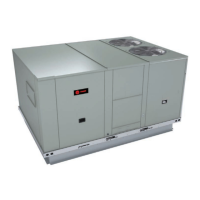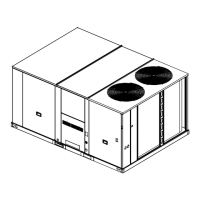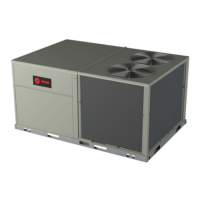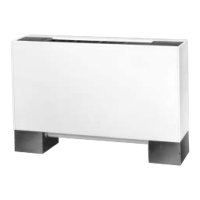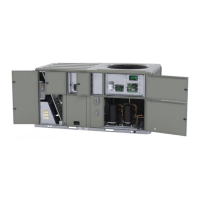20 RT-SVX055D-EN
Start Up
Sequence of Operation
These units are offered with electromechanical controls.
Note: The Condensate Overflow Switch (COF) (optional)
will shut the
unit down if the float is raised and the
switch is closed.
Electromechanical Controls
Electromechanical Control Cooling without an
Economizer
When the thermostat switch is set to the "Cool" position
and the zone temperature rises above the cooling setpoint,
the thermostat Y contacts close. The compressor
contactor (CC1) coil is energized provided the low pressure
control (LPC1), high pressure control (HPC1) and
discharge line thermostat (DLT 1) are closed. When the
(CC1) contacts close, compressor (CPR1) and both outdoor
fan motors (ODM1 and ODM2) start. If the first stage of
cooling cannot satisfy the cooling requirement, the
thermostat closes Y2. The compressor contactor (CC2) coil
is energized provided the low pressure control (LPC2),
high pressure control (HPC2) and discharge line
thermostat (DLT 2) are closed.
When the (CC2) contacts close, compressor (
CPR2) starts.
Electromechanical Evaporator
Fan Operation
When the thermostat fan selection switch is set to the
"Auto" position, the thermostat energizes the indoor fan
relay coil (F) to start the indoor fan motor (IDM).The fan
relay (F) de-energizes after the cooling requirement has
been satisfied. When the heating cycle is terminated, the
indoor fan relay (F) coil is de-energized with heater
contactors.
When the thermostat fan selection switch is set to the "On"
position, the thermostat
keeps the indoor fan relay coil (F)
energized for continuous fan motor operation.
Electromechanical Control Heating Operation
(Units with Electric Heat)
When the system switch is set to the "Heat" position and
the zone temperature falls below the heating setpoint, the
thermostat closesW1 contacts the first stage electric heat
contactor (AH or AH & CH) is energized. If the first stage of
electric heat cannot satisfy the heating requirement, the
thermostat closes W2.
When the W2 contacts close, the
second stage electric heat
contactor (BH or BH & DH) is energized, if applicable. The
thermostat cycles both the first and second stages of heat
"On" and "Off" as required to maintain the zone
temperature setpoint.
Drain Pan Condensate Overflow Switch
(Optional)
The Condensate Overflow Switch (COF) is utilized to
prevent water overflow from the drain pan. The float
switch is installed on the corner lip of the drain pan. When
the condensate level reaches the trip point, the COF relay
energizes and opens the 24VAC control circuit which
disables the unit. Once the 24VAC control circuit is opened,
a delay timer will prevent unit start-up for three minutes.
Low Ambient Operation (Optional)
During low ambient operation, outside air temperature
below 50°F, the Low Ambient Controller will cycle the
outdoor fan motor "Off" and "On" based on discharge
pressure. The indoor fan motor (IDM) will continue to
operate and the outdoor fan will return to normal
operation once the ambient temperature is above 50°F.
10 Horsepower Motor Overload
10HP indoor fan motors are not internally protected. For
proper protection, ensure the adjustable dial on the front
of the overload (located in the control box) is set to the
nameplate FLA value of the indoor motor.
Compressor Start-Up
1. Attach a set of service gauges onto the suction and
discharge gauge ports for each circuit. Refer to the
refrigerant circuit illustration in the Service Facts.
Using the Service Test Guide, per
form
the proper test
mode connections.
Scroll Compressors
a. Once each compressor has started, verify that the
rotation is correct.
If wired correctly the suction
pressure should drop and the discharge pressure
should rise. If a scroll compressor is rotating
backwards, it will not pump and a loud rattling
sound can be observed.
b. If the electrical phasing is correct, before
co
ndem
ning a compressor, interchange any two
leads (at the compressor Terminal block) to check
the internal phasing. Refer to the following
illustration for the compressor terminal/phase
identification. Do not allow the compressor to
operate backwards for more than 5 seconds.
Operation for a period of time longer than this will
result in compressor damage. Copeland (Alliance)
will experience failure also. If the compressor runs
backward for an extended period, the motor
winding can overheat and cause the motor winding
thermostat to open.
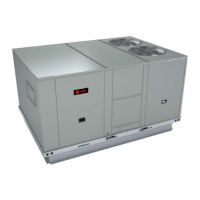
